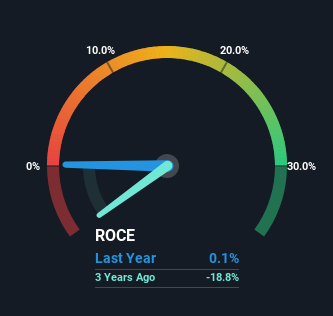Mammoth Energy Services (NASDAQ:TUSK) Has Some Difficulty Using Its Capital Effectively
When researching a stock for investment, what can tell us that the company is in decline? Businesses in decline often have two underlying trends, firstly, a declining return on capital employed (ROCE) and a declining base of capital employed. This indicates the company is producing less profit from its investments and its total assets are decreasing. And from a first read, things don't look too good at Mammoth Energy Services (NASDAQ:TUSK), so let's see why.
Understanding Return On Capital Employed (ROCE)
For those who don't know, ROCE is a measure of a company's yearly pre-tax profit (its return), relative to the capital employed in the business. To calculate this metric for Mammoth Energy Services, this is the formula:
Return on Capital Employed = Earnings Before Interest and Tax (EBIT) ÷ (Total Assets - Current Liabilities)
0.0013 = US$642k ÷ (US$693m - US$205m) (Based on the trailing twelve months to June 2023).
Therefore, Mammoth Energy Services has an ROCE of 0.1%. Ultimately, that's a low return and it under-performs the Energy Services industry average of 13%.
See our latest analysis for Mammoth Energy Services
While the past is not representative of the future, it can be helpful to know how a company has performed historically, which is why we have this chart above. If you're interested in investigating Mammoth Energy Services' past further, check out this free graph of past earnings, revenue and cash flow.
How Are Returns Trending?
The trend of ROCE at Mammoth Energy Services is showing some signs of weakness. To be more specific, today's ROCE was 42% five years ago but has since fallen to 0.1%. In addition to that, Mammoth Energy Services is now employing 27% less capital than it was five years ago. When you see both ROCE and capital employed diminishing, it can often be a sign of a mature and shrinking business that might be in structural decline. If these underlying trends continue, we wouldn't be too optimistic going forward.
Our Take On Mammoth Energy Services' ROCE
In short, lower returns and decreasing amounts capital employed in the business doesn't fill us with confidence. Unsurprisingly then, the stock has dived 83% over the last five years, so investors are recognizing these changes and don't like the company's prospects. Unless there is a shift to a more positive trajectory in these metrics, we would look elsewhere.
If you want to continue researching Mammoth Energy Services, you might be interested to know about the 1 warning sign that our analysis has discovered.
While Mammoth Energy Services isn't earning the highest return, check out this free list of companies that are earning high returns on equity with solid balance sheets.
Have feedback on this article? Concerned about the content? Get in touch with us directly. Alternatively, email editorial-team (at) simplywallst.com.
This article by Simply Wall St is general in nature. We provide commentary based on historical data and analyst forecasts only using an unbiased methodology and our articles are not intended to be financial advice. It does not constitute a recommendation to buy or sell any stock, and does not take account of your objectives, or your financial situation. We aim to bring you long-term focused analysis driven by fundamental data. Note that our analysis may not factor in the latest price-sensitive company announcements or qualitative material. Simply Wall St has no position in any stocks mentioned.

